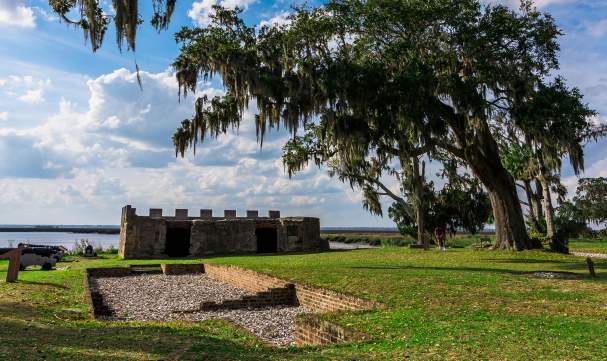St. Simons Island History
St. Simons Island is dotted with exceptional historic sites and attractions, from the St. Simons Lighthouse Museum—a working lighthouse built in 1872—to the Bloody Marsh Battle Site, where, in July 1742, British and Scottish soldiers protecting colonial Georgia defeated a larger Spanish force in a battle that helped end Spanish incursions outside Florida.
On the island's north end, Cannon's Point Preserve is not to be missed. This visitor favorite contains middens dating back to 2500 BCE. Fort Frederica National Monument, which preserves archeological remnants of the local British colony and its defense against Spain, and historic Christ Church, Frederica—one of the oldest churches in Georgia, with worship held continuously since 1736—are also located on the island’s north end. History buff or not, you won't want to miss Christ Church's picturesque and somewhat haunting grounds.
Where are other places visitors can find evidence of St. Simons Island's unique history?

Fort Frederica
A ride to the north end of St. Simons Island with a visit to Fort Frederica provides visible evidence of the English occupation that followed. Having laid out the town of Savannah in 1733, Oglethorpe realized the importance of protection from the Spanish to the south. A bend in the Frederica River provided a perfect place to locate a fort and town. The Anglican Wesley brothers, who accompanied Oglethorpe, first preached under the oaks at Frederica (current site of Christ Church, Frederica) in 1736. After returning to England, the brothers established the Methodist Church.
Following the defeat of the Spanish at the Battle of Bloody Marsh, the fort fell into disuse. The ruins yielded chunks of tabby to build plantation houses in the late 1700s. At that point, the era of plantations that grew Sea Island cotton began. Timber for the country’s first navy came from St. Simons, with the mast post of the Constitution, cut in John Couper’s yard.
The planter families built Christ Church on the north end of the island near the old fort and cultivated the island up until the Civil War. Today only a few tabby slave cabins attest to that era, while the families rest in quiet of the cemetery behind Christ Church. The cemetery also bears witness to sons lost in the Civil War.
Hamilton Plantation
The Historic Hamilton Plantation Cabins and Grounds at Gascoigne Bluff, now maintained by the Cassina Garden club and open to the public, give little evidence of the number of board feet of timber milled there following the Civil War. The mills provided jobs for both the planters and freed slaves. It also brought Anson Green Phelps Dodge, Jr. to the island. His rebuilding of devastated Christ Church and the sadness in his life became the story of the late Eugenia Price’s novel, Beloved Invader.
Learn more about the African American history of St. Simons Island.
African-Americans who have lived in the Golden Isles have left an indelible mark on the area for centuries. From passed-down folklore, food and music traditions, significant contributions have been made to the culture of the Golden Isles and Georgia coast as a whole. It is our honor to share…
Georgia Coast Field Trip Ideas
With a place as beautiful as the Golden Isles of Georgia, it seems a near crime to be cooped up inside for too long. From historic sites to marine ecosystems, the magic of learning can be found…



